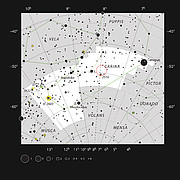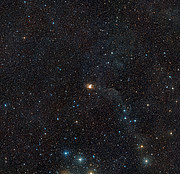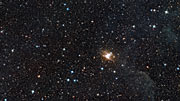Comunicato Stampa
Uno sguardo ravvicinato alla nebulosa della caraffa Toby Jug
09 Ottobre 2013
Il Very Large Telescope (VLT) dell'ESO ha ripreso un'immagine notevolmente dettagliata della nebulosa della caraffa (chiamata Toby Jug in inglese), una nube di gas e polvere che circonda una stella gigante rossa. Questa vista mostra la tipica struttura ad arco della nebulosa, che assomiglia ad una piccola caraffa con un manico.
Situata a circa 1200 anni-luce dalla Terra nella costellazione australe della Carena, la nebulosa della caraffa Toby Jug, formalmente conosciuta come IC 2220, è un esempio di una nebulosa a riflessione. È una nube di gas e polvere illuminata dall'interno da una stella chiamata HD 65750. Questa stella gigante rossa ha cinque volte la massa del Sole, ma si trova in una fase molto più avanzata della sua vita, malgrado la sua relativamente giovane età di 50 milioni di anni.
La nebulosa è stata creata dalla stella che perde una parte della sua massa nello spazio circostante, formando una nube di gas e polvere mentre questo materiale si raffredda. La polvere consiste di elementi come il carbonio e di elementi semplici resistenti al calore come il diossido di titanio e l'ossido di calcio. In questo caso studi dettagliati dell'oggetto nella luce infrarossa puntano verso il diossido di silicio (silicea) come il componente più verosimile per riflettere la luce stellare.
IC2220 è visibile poiché la luce stellare è riflessa dai chicchi di polvere. Questa struttura celeste a forma di farfalla è quasi simmetrica e occupa circa un anno-luce. Questa fase stellare è corta e quindi oggetti simili sono rari.
Le giganti rosse sono formate da stelle che invecchiano e che si avvicinano alle fasi finali della loro evoluzione. Esse hanno quasi esaurito le loro riserve di idrogeno, che rifornisce le reazioni che accadono durante la maggior parte della vita della stella. Ciò provoca l'enorme espansione dell'atmosfera della stella. Stelle come HD 65750 bruciano un involucro di elio attorno al cuore di carbonio-ossigeno, qualche volta accompagnato da un involucro di idrogeno più vicino alla superficie stellare.
Tra alcuni miliardi di anni anche il nostro Sole si trasformerà in una gigante rossa. L'atmosfera si gonfierà ben aldilà dell'orbita odierna della Terra, ingoiando tutti i pianeti interni. A questo punto la Terra sarà già in cattivissime condizioni. Il tremendo aumento di radiazioni e forti venti stellari che accompagnano il processo dell'inflazione stellare distruggeranno tutta la vita sulla Terra e faranno evaporare l'acqua degli oceani, prima che l'intero pianeta sia infine fuso.
Gli astronomi inglesi Paul Murdin, David Allen e David Malin hanno dato a IC 2220 il nome della caraffa poiché la sua forma ricordava loro una vecchia brocca della loro infanzia, chiamata Toby Jug.
Questa immagine è stata prodotta come parte del programma dell'ESO "Gemme Cosmiche". [2]
Note
[1] Le stelle più massicce trascorrono la loro vita molto più velocemente delle stelle più leggere come il Sole, che hanno una durata di vita di miliardi, invece che di milioni di anni.
[2] Questa immagine è stata prodotta come parte del programma dell'ESO "Gemme Cosmiche". E" una nuova iniziativa volta a produrre immagine di oggetti interessanti, misteriosi o anche semplicemente belli utilizzando i telescopi dell'ESO a scopo divulgativo e di formazione. Il programma sfrutta una piccolissima parte di tempo osservativo, combinato con tempo non utilizzato dai normali programmi dei telescopi, in modo da minimizzare l'impatto con le osservazioni scientifiche. Tutti i dati raccolti sono resi disponibili anche agli astronomi attraverso l'archivio scientifico dell'ESO
Ulteriori Informazioni
L’ESO (European Southern Observatory) è la principale organizzazione intergovernativa di Astronomia in Europa e l’osservatorio astronomico più produttivo al mondo. È sostenuto da 15 paesi: Austria, Belgio, Brasile, Danimarca, Finlandia, Francia, Germania, Gran Bretagna, Italia, Olanda, Portogallo, Repubblica Ceca, Spagna, Svezia, e Svizzera. L’ESO svolge un ambizioso programma che si concentra sulla progettazione, costruzione e gestione di potenti strumenti astronomici da terra che consentano agli astronomi di realizzare importanti scoperte scientifiche. L’ESO ha anche un ruolo di punta nel promuovere e organizzare la cooperazione nella ricerca astronomica. L’ESO gestisce tre siti osservativi unici al mondo in Cile: La Silla, Paranal e Chajnantor. Sul Paranal, l’ESO gestisce il Very Large Telescope, osservatorio astronomico d’avanguardia nella banda visibile e due telescopi per survey. VISTA, il più grande telescopio per survey al mondo, lavora nella banda infrarossa mentre il VST (VLT Survey Telescope) è il più grande telescopio progettato appositamente per produrre survey del cielo in luce visibile. L’ESO è il partner europeo di un telescopio astronomico di concetto rivoluzionario, ALMA, il più grande progetto astronomico esistente. L’ESO al momento sta progettando l’European Extremely Large Telescope o E-ELT (significa Telescopio Europeo Estremamente Grande), della classe dei 40 metri, che opera nell'ottico e infrarosso vicino e che diventerà “il più grande occhio del mondo rivolto al cielo”.
Links
pagina delle "Gemme Cosmiche" dell'ESO
Contatti
Richard Hook
ESO, Public Information Officer
Garching bei München, Germany
Tel.: +49 89 3200 6655
Cell.: +49 151 1537 3591
E-mail: rhook@eso.org
Sul Comunicato Stampa
| Comunicato Stampa N": | eso1343it-ch |
| Nome: | IC 2220 |
| Tipo: | Milky Way : Nebula : Appearance : Reflection |
| Facility: | Very Large Telescope |





